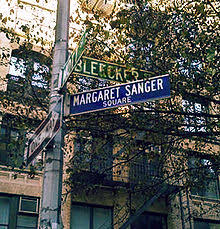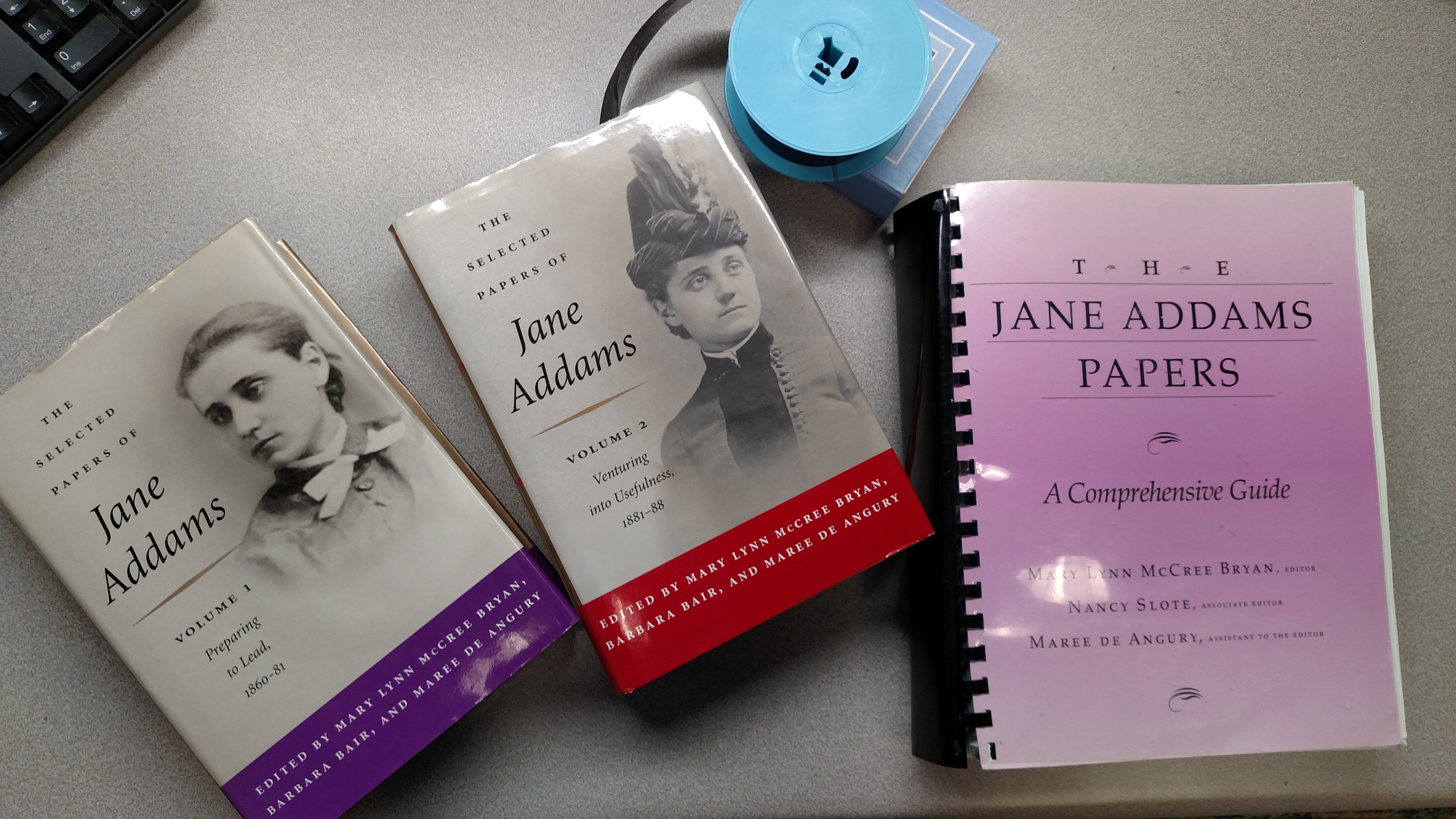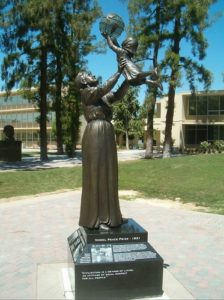
We have all been thinking and talking about monuments, about how they are created, what they mean, and when or whether they should come down. Whether it is the toppling of the likeness of Christopher Columbus in Minnesota, efforts to remove the Robert E. Lee statue in Richmond, or the removal of Margaret Sanger’s name from Planned Parenthood of New York’s downtown clinic, the meaning of monuments and our understanding of the past is being challenged. Monuments are a problematic way to understand history. They are a one-note, simplistic way of claiming that a person mattered to the people that put them up. Over time, they become something else, icons of the cities in which they are located, and a shorthand guide to a history that glorified mostly male and mostly white political and military leaders. They offer a simple message — hey, this guy was great! We understand the danger of this kind of simplification when talking about living people. We even have a phrase to warn us about the risks of doing it — putting someone on a pedestal — or to believe or behave as if someone is perfect to the extent that one ignores that person’s flaws or faults.

And it is the faults and the flaws of the people we have honored with monuments that are being exposed now. It is past time. No one, now or then, is perfect. How can we reconcile honoring an individual who owned slaves, or who fought against the Union, or who held racist, sexist, or eugenic views? On the flip side, how can we ignore the context of the times they lived in? Is it right to hold people to ahistorical standards of behavior? We have to place people in historical context, based on an understanding of what the world was like when they lived. This isn’t just making excuses or becoming an apologist for figures from the past. We have to stop seeing people as either good or evil, heroes or villains, and instead be able to see the grey, to praise what they did well and condemn what they did that was intolerable. We have to stop putting them on pedestals.
A Better Way to Learn About the Past

If a monument is too simplistic — too one-note — to convey the complexity of a human life and the historical times they lived in, what is the alternative? I would argue that it is the documentary edition, made freely available, that brings understanding of the complexities of the past. My career as a historian has been as a documentary editor, first with the Margaret Sanger Papers, and now with the Jane Addams Papers, so I may be biased, but I also speak from experience.
A documentary edition is not a film, it is a compilation of historical documents, prepared by scholars, on a theme of historical importance. It is usually centered around a single person’s life, but occasionally describes a group, such as the Freedmen and Southern Society Project or the Yale Indian Project’s Native Northeast Portal.
We center the work around the words of the historical figure
Much of the work of the editor revolves around finding, selecting, and transcribing the letters, speeches, diaries, and other texts produced by a historical figure. We use our historical training and long hours of reading literally everything a person wrote to select documents that offer a nuanced and complex view of that person’s life and career.
We don’t shirk from the negative or controversial. When selecting documents for the Selected Papers of Margaret Sanger, we made sure that her views on race, on eugenics, and on abortion were included alongside her views on women’s rights, civil liberties, and reproductive freedom. With the Selected Papers of Jane Addams, we look to highlight Addams’s views on race, poverty and immigration, just as much as her ideas about social work and peace.

Many editions create two products. The first is a comprehensive edition, often digital nowadays, but in the past they were published on microfilm. These collections, resulting from years-long searches in archives and private collection, are extremely valuable for scholars because they bring together materials that were dispersed over the globe. The selected edition, often published in book form, though increasingly in digital form, takes the most historically significant materials and adds annotation, to create a readable series that tells a shorter, yet nuanced, story of the figure’s life.
We work really hard to make sure that the texts of the documents that you read in our editions are accurate and complete. You won’t find snippets of texts removed or taken out of their context in order to make an argument. We proofread the transcriptions as many times as is needed to get a good, accurate text. The focus is on the document, and by reading them, one after another, you gain a deeper, personal understanding of the subject.
We provide historical context, but leave interpretation to you
Editions use annotation (headnotes, footnotes, and introductory texts) to give the reader a sense of the times, to fill in the gaps when the texts don’t do it. Editorial annotation is not the same as historical interpretation. This was brought to my attention when working on an early draft of my dissertation on birth control clinics, when my adviser, Linda Gordon, pointed out that I wasn’t disclosing what I thought about all the materials. My text was descriptive and it needed to be analytical and interpretive. I was writing like an editor, carefully researching and describing situations, but not bringing my own views, ideas, and analysis to the foreground. Writing an interpretive narrative is a different animal, one in which your experiences and the times in which you live color the way that you approach a topic. Think about multiple biographies of the same person — the basics of their lives stay the same, but the questions we ask, the values we bring to the topic affect the way that we view and interpret the past. Editors aren’t immune to those same biases, but our approach is different.
Our annotation is document-driven. What I mean by that is that we look at the texts, written by our subjects, and explore their content. When a person or event or topic is mentioned, we add a footnote to explain who or what they are talking about. There is no better training than researching for a documentary edition. You don’t get to decide that the topic is too hard and you can’t skip over things or change your research direction, like you might do in a monograph or term paper. These notes are generally short and informational rather than interpretive, which teaches you to be precise and succinct. Reading the text with the footnotes helps the reader understand things that a contemporary reader would already know. I liken it to reading with the town busybody standing over your shoulder, providing you with the backstory for each document. Except that busybody is a historian.

Annotation can also fill gaps in documentation. The nature of a selected edition is that we have left many, many documents out. For example, we selected a letter written to Theodore Roosevelt from Addams in 1912 about her role in winning women to the Progressive Party. This was not the first letter written about the topic, so we use annotation to summarize what already occurred before that document was written. It brings the reader up to the now. We also use annotation to refer readers to material in archives and in our comprehensive microfilm or digital edition where they can go deeper.
Where does interpretation fit in all this? After reading so much and researching every bit of a person’s life, editors do form opinions and interpretations. They might turn up in the introduction to a volume, a conference paper, a blog post, journal article, or monograph. The litmus test, for me, is whether a person who doesn’t like the subject can use our work with confidence. Will they trust that you haven’t hid or obscured documents or other materials that could make your subject look bad? My favorite review of the first volume of the Selected Papers of Margaret Sanger was from the Weekly Standard, where David Tell wrote:
Somewhere, amidst the sucker punches and cries of foul, the truth must reside. And “somewhere,” it turns out, is the enormous and altogether dazzling selection of public and private records just put out by the manuscript curators at New York University’s “Margaret Sanger Papers Project.” They too, like the earlier biographers, unambiguously admire the woman. But they have done their editing with scrupulous care, they have annotated the documents they reproduce with monk-like dispassion, and on the face of it they have held nothing back. (January 27, 2003)
History for the Masses
Digital scholarly editions, made freely available, are a far better monument to the life of a historical figure than statues or buildings could ever be. They provide a historically accurate, nuanced look at a life. They show the moments of weakness as well as moments of great strength and more than biographies or statues ever can, they render historical figures as real people. People with problems, people who have difficult family members, who follow fad diets, watch plays and movies, and fully lived in their times. They also foster critical thinking about historical figures and moments. While editions won’t fit easily into 140 characters or a 15-second TikTok video; neither does history.
Who we select to be the subjects of editions matters
Editions don’t stand outside society, and there has been a long history of privileging the papers of white male politicians and military leaders. Whether the founding fathers, presidents, or generals, the subjects of these editions sound much like the names on monuments, and the names we all learned in history books. The editions of these papers provide a more nuanced view of those lives, including co-workers, rivals, families, and in some cases, slaves.

In the 1970s, the field began to open up, adding a handful of projects featuring women and African-Americans. But it is not enough. We need to broaden the topics of editions to include the voices of marginalized peoples. And we need to broaden the range of people who become editors, because more voices will reveal a more vibrant story of America’s past. Smaller projects, based on intriguing people reveal lives and stories that have been erased from popular notions of history. It is happening, albeit slower than we would like.
Thinking again about monuments, I wonder if there might be an “edition-worthy” check before you put up a monument. Could you devote years of research, funding, and scholarly effort to create the Papers of Edmund Pettus? And after you had done so, exploring his ideas and providing context for his military career, his political views, and his leadership in the Ku Klux Klan, would you build a statue or name a bridge after him?
Cathy Moran Hajo is the Editor and Director of the Jane Addams Papers Project at Ramapo College of New Jersey. She is an experienced scholarly editor, having previously worked for over 25 years as Associate Editor at the Margaret Sanger Papers at New York University. Dr. Hajo received her Ph.D. in history from New York University in 2006, and is addition to her work on the Sanger Papers, published “Birth Control on Main Street, Organizing Clinics in the United States, 1916-1940,” in 2010.
Her teaching interests include scholarly editing and digital history, and she currently teaches for the Institute for Editing Historical Documents, the Digital Humanities Summer Institute. She teaches a digital history course at Ramapo College.


WOW! What a wonderful explanation of documentary editing, monuments, and historical thinking! Thank you so much for this.
Thank you for this marvelous and timely essay on the enduring monuments to history that are contained in well-edited, well-researched editions of actual documentary evidence, which become the solid foundations for all serious explorations of the past.
Congratulations Cathy on this perfect and timely piece. I am sending it out to many others.
Excellent! I’m sharing this clear definition of documentary editing with a colleague who’s teaching a “Writing History” course this coming semester. Thank you!
One of the best justifications for historical editions yet!
Thank you, Cathy. As others have stated, your essay deserves wide circulation so others outside our profession can appreciate what we contribute.
Sound and insightful. Thank you, Cathy.